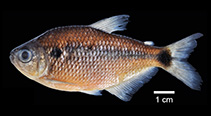| Family: |
Characidae (Characins; tetras), subfamily: Stethaprioninae |
| Max. size: |
8.3 cm SL (male/unsexed); 8.98 cm SL (female) |
| Environment: |
benthopelagic; freshwater |
| Distribution: |
South America, Colombia. |
| Diagnosis: |
This species, a member of the orthodus species-group of Astyanax, differs from other members of the group by the following characters: differs from villwocki, superbus, gandhiae, bopiensi, boliviensis, yariguies by the absence of a dark stripe on the sides of the body (vs. dark lateral stripe present or anterior prolongation of the caudal peduncle spot extending anteriorly over the silvery lateral stripe); differs from A. orthodus in having the caudal peduncle spot extending onto the ventral and dorsal margins of the caudal peduncle, covering 4-6 horizontal scale rows (vs. covering 2-4 horizontal scale rows on the caudal peduncle) and in having an unpigmented band across the anal-fin rays in both sexes (vs.pigmentation uniform on analfin rays); differs from A. moorii in body depth > 39% SL (vs. < 39% SL), the dorsal-pectoral fin distance > 40.5% SL (vs. < 40.5% SL), maxilla length < 33.5% HL (vs. > 33.5% SH), upper jaw length < 32% HL (vs. > 47% SH) and by the number of lateral-line scales 36-41 (vs. 44-50) (Ref. 119406). |
| Biology: |
|
| IUCN Red List Status: |
Not Evaluated (N.E.) Ref. (130435)
|
| Threat to humans: |
harmless |
Source and more info: www.fishbase.org. For personal, classroom, and other internal use only. Not for publication.
